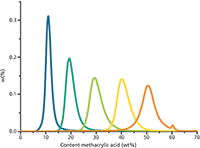Separation of Statistic MMA-MAA Copolymers Using Gradient SEC
Statistic copolymers of methyl methacrylate (MMA) and methacrylic acid (MAA) are widely used in pharmaceutical applications.
Statistic copolymers of methyl methacrylate (MMA) and methacrylic acid (MAA) are widely used in pharmaceutical applications. Aside from the molar mass distribution, the chemical composition and the amount of comonomers in the copolymer is of importance. Separations by conventional gradient high performance liquid chromatography (HPLC) failed, since the polar eluents required to dissolve polymers with a high acid content prevent adsorption onto the stationary phase, resulting in pronounced breakthrough peaks. The problem can be avoided by applying size-exclusion chromatography (SEC)-gradients, resulting in the desired separation according to the amount of methacrylic acid. The system can be calibrated using reference materials of known composition. This allows the average copolymer composition as well as the compositional heterogeneity to be determined.
Experimental
GPC–SEC analysis was performed on a PSS SECcurity GPC System comprising a 1260 binary pump, a 1260 autosampler, and an ELSD1000.
The analysis conditions were:
Columns: PSS PROTEEMA, 3-µm, 100 Å (8 × 300 mm) + precolumn
Solvent: Gradient: Chloroform/DMAc, flow-rate 1 mL/min
0–3 min: 50% DMAc
3–8 min: 100% DMAc
8–23 min: 100% CHCl3
23–26 min: 5% DMAc
26–32 min: linear increase from 5% to 50% DMAc
Temperature: 60 °C
Calibration: PSS MMA-MAA copolymers of different acid content (MAA: 9%, 25%, 31%, 42%, 48% wt)
Concentration: 1 g/L
Inject volume: 100 µL, injection interval 32 min
Software: PSS WinGPC UniChrom 8.0
Procedure, Results, and Discussion
The experimental procedure for SEC-gradients differs from conventional gradient HPLC. In conventional HPLC the sample is dissolved in a weak eluent and injected at adsorbing conditions; in SEC-gradient the sample is dissolved in a strong mobile phase and injected at the end of the SEC-gradient. In the present application the copolymers were dissolved in DMAc.

Figure 1: Separation of 5 MMA-MAA copolymers with different PMMA content using a Chloroform - DMAc gradient on PSS PROTEEMA columns.
Figure 1 shows the separation of five statistical MMA-MAA copolymers with MAA contents between 9% and 48% wt using a Chloroform/DMAc gradient from 5% to 50% DMAc. The sample components elute before the injected solvent and the different samples are clearly separated.

Figure 2: Chemical composition distribution for 5 MMA-MAA copolymers. For MAA content see Figure 1.
A nearly linear dependence between MAA content and elution volume is observed. The use of this calibration curve allows the determination of the chemical composition distribution. Figure 2 shows the chemical composition distribution for the five samples with the PMAA content between 48% and 9%. It is observed that an increase in MAA content results in a significantly broader chemical composition distribution (CCD).

PSS-USA, Inc.
Amherst Fields Research Park,
160 Old Farm Road, Ste. A, Amherst, MA 01002
tel. (413) 835-0265, fax: (413) 835-0354
Website: www.pss-polymer.com

SEC-MALS of Antibody Therapeutics—A Robust Method for In-Depth Sample Characterization
June 1st 2022Monoclonal antibodies (mAbs) are effective therapeutics for cancers, auto-immune diseases, viral infections, and other diseases. Recent developments in antibody therapeutics aim to add more specific binding regions (bi- and multi-specificity) to increase their effectiveness and/or to downsize the molecule to the specific binding regions (for example, scFv or Fab fragment) to achieve better penetration of the tissue. As the molecule gets more complex, the possible high and low molecular weight (H/LMW) impurities become more complex, too. In order to accurately analyze the various species, more advanced detection than ultraviolet (UV) is required to characterize a mAb sample.















